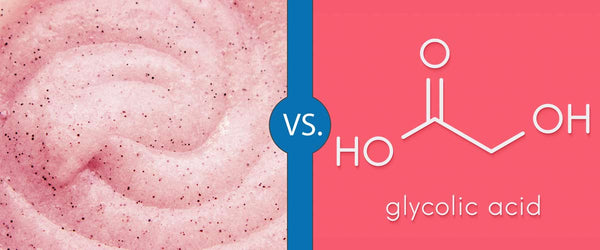Skin Care Advice

Exfoliating Peeling Skin: Glycolic Acid Peels or Facial Scrubs?
Exfoliation is an extremely important part of any skin care routine. Dead skin cells on the surface of the skin tend to accumulate around fine lines and wrinkles, causing them to appear deeper. Dead skin also worsens the effects of hyperpigmentation. Exfoliation removes the buildup of these dead skin cells, making it an essential step in maintaining healthy-looking skin.
But what’s the best way to exfoliate? Those sugar scrubs and face scrubs with microbeads are very popular, but are they the best options for your skin? Are chemical peels as dangerous and scary as they sound? Let’s investigate a few factors.
What Exactly Is Glycolic Acid?
Glycolic acid is an Alpha Hydroxy Acid, or AHA (not to be confused with 80’s one-hit wonder A-ha.) AHAs are also known as fruit acids, and glycolic is the most popular and well known of the group.
Glycolic acid comes from sugar cane and is a naturally occurring compound.
Glycolic acid is milder than many other chemical peel ingredients, while still having the strength to yield significant results.
What Are Facial Scrubs?
This may seem like a silly question to answer, as most of you are probably already very familiar with facial scrubs. They’re extremely common to find at stores and are typically composed of an abrasive material (plastic microbeads, sea salt, sugar, etc.) suspended in a lotion, oil, or face wash.
The Verdict:
Facial scrubs are popular and widely available, and are considered safe to use, although your exfoliation results and potential for skin irritation can vary greatly depending on how you scrub. Glycolic acid, on the other hand, is a lot easier to control as far as exfoliation results and irritation go. By being able to directly control the strength of glycolic acid you’re using and how long you leave it on, you will see greater control and consistency in your results. Additionally, you will not be running the risk of scratching the surface of your live skin cells and damaging them.
The glycolic acid available in our store comes from Advanced Skin Care, and is available in 30%, 50%, and 70% concentrations, with no other additives.
